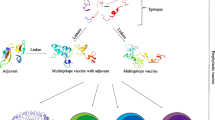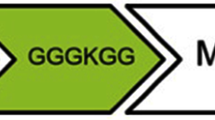Abstract
Mycobacterium tuberculosis (Mtb) 16.3 kDa heat shock protein 16.3 (HSP16.3) is a latency-associated antigen that can be targeted for latent tuberculosis (TB) diagnostic and therapeutic development. We have previously developed human VH domain antibodies (dAbs; clone E3 and F1) specific against HSP16.3. In this work, we applied computational methods to optimise and design the antibodies in order to improve the binding affinity with HSP16.3. The VH domain antibodies were first docked to the dimer form of HSP16.3 and further sampled using molecular dynamics simulation. The calculated binding free energy of the HSP16.3-dAb complexes showed non-polar interactions were responsible for the antigen–antibody association. Per-residue free energy decomposition and computational alanine scanning have identified one hotspot residue for E3 (Y391) and 4 hotspot residues for F1 (M394, Y396, R397 and M398). These hotspot residues were then mutated and evaluated by binding free energy calculations. Phage ELISA assay was carried out on the potential mutants (E3Y391W, F1M394E, F1R397N and F1M398Y). The experimental assay showed improved binding affinities of E3Y391W and F1M394E against HSP16.3 compared with the wild type E3 and F1. This case study has thus showed in silico methods are able to assist in optimisation or improvement of antibody-antigen binding.




Similar content being viewed by others
References
Chowdhury PS, Wu H (2005) Tailor-made antibody therapeutics. Methods 36:11–24
Carter PJ (2006) Potent antibody therapeutics by design. Nat Rev Immunol 6:343–357
Sormanni P, Aprile FA, Vendruscolo M (2015) Rational design of antibodies targeting specific epitopes within intrinsically disordered proteins. Proc Natl Acad Sci USA 112:9902–9907
Kuroda D, Shirai H, Jacobson MP, Nakamura H (2012) Computer-aided antibody design. Protein Eng Des Sel 25:507–522
Clark LA, Boriack-Sjodin PA, Eldredge J, Fitch C, Friedman B, Hanf KJ, Jarpe M, Liparoto SF, Li Y, Lugovskoy A (2006) Affinity enhancement of an in vivo matured therapeutic antibody using structure-based computational design. Protein Sci 15:949–960
Kiyoshi M, Caaveiro JMM, Miura E, Nagatoishi S, Nakakido M, Soga S, Shirai H, Kawabata S, Tsumoto K (2014) Affinity improvement of a therapeutic antibody by structure-based computational design: Generation of electrostatic interactions in the transition state stabilizes the antibody-antigen complex. PLoOS ONE 9:e87099
Kaushik A, Singh UB, Porwal C, Venugopal SJ, Mohan A, Krishnan A, Goyal V, Banavaliker JN (2012) Diagnostic potential of 16 kDa (HspX, alpha-crystalline) antigen for serodiagnosis of tuberculosis. Indian J Med Res 135:771–777
Ziegenbalg A, Prados-Rosales R, Jenny-Avital ER, Kim RS, Casadevall A, Achkar JM (2013) Immunogenicity of mycobacterial vesicles in humans: identification of a new tuberculosis antibody biomarker. Tuberculosis (Edinb) 93:448–455
Li Q, Yu H, Zhang Y, Wang B, Jiang W, Da Z, Xian Q, Wang Y, Liu X, Zhu B (2011) Immunogenicity and protective efficacy of a fusion protein vaccine consisting of antigen Ag85B and HspX against Mycobacterium tuberculosis infection in mice. Scand J Immunol 73:568–576
Bahara NHH, Chin ST, Choong YS, Lim TS (2016) Construction of a semisynthetic human VH single-domain antibody library and selection of domain antibodies against α-crystalline of Mycobacterium tuberculosis. J Biomol Screen 21:35–43
Wu Y, Jiang S, Ying T (2017) Single-domain antibodies as therapeutics against human viral diseases. Front Immunol 8:1802
Šali A, Blundell TL (1993) Comparative protein modelling by satisfaction of spatial restraints. J Mol Biol 234:779–815
Bernstein FC, Koetzle TF, Williams GJ, Meyer EF Jr, Brice MD, Rodgers JR, Kennard O, Shimanouchi T, Tasumi M (1977) The protein data bank: a computer-based archival file for macromolecular structures. J Mol Biol 112:535–542
Shen M-y, Sali A (2006) Statistical potential for assessment and prediction of protein structures. Protein Sci 15:2507–2524
Laskowski RA, MacArthur MW, Moss DS, Thornton JM (1993) PROCHECK: a program to check the stereochemical quality of protein structures. J Appl Cryst 26:283–291
Bowie JU, Luthy R, Eisenberg D (1991) A method to identify protein sequences that fold into a known three-dimensional structure. Science 253:164–170
Luthy R, Bowie JU, Eisenberg D (1992) Assessment of protein models with three-dimensional profiles. Nature 356:83–85
Benkert P, Künzli M, Schwede T (2009) QMEAN server for protein model quality estimation. Nucleic Acids Res 37:W510–W514
Soong JX, Lim TS, Choong YS (2018) The structural insights of 16.3 kDa heat shock protein (HSP16.3) from Mycobacterium tuberculosis via in silico study. Mol Simul 44:117–127
Davydov YI, Tonevitsky AG (2009) Prediction of linear B-cell epitopes. Mol Biol 43:150–158
Larsen JEP, Lund O, Nielsen M (2006) Improved method for predicting linear B-cell epitopes. Immunome Res 2:2–2
Kringelum JV, Lundegaard C, Lund O, Nielsen M (2012) Reliable B cell epitope predictions: impacts of method development and improved benchmarking. PLoS Comput Biol 8:e1002829
Ponomarenko J, Bui HH, Li W, Fusseder N, Bourne PE, Sette A, Peters B (2008) ElliPro: a new structure-based tool for the prediction of antibody epitopes. BMC Bioinform 9:514
Lian Y, Ge M, Pan X-M (2014) EPMLR: Sequence-based linear B-cell epitope prediction method using multiple linear regression. BMC Bioinform 15:1–6
El-Manzalawy Y, Dobbs D, Honavar V (2008) Predicting flexible length linear B-cell epitopes. Comput Syst Bioinform Conf 7:121–132
Srivastava SK, Ruigrok VJB, Thompson NJ, Trilling AK, Heck AJR, van Rijn C, Beekwilder J, Jongsma MA (2013) 16 kDa heat shock protein from heat-inactivated Mycobacterium tuberculosis is a homodimer—suitability for diagnostic applications with specific llama VHH monoclonals. PLoS ONE 8:e64040
Pierce BG, Hourai Y, Weng Z (2011) Accelerating protein docking in ZDOCK using an advanced 3D convolution library. PLoS ONE 6:e24657
Chermak E, Petta A, Serra L, Vangone A, Scarano V, Cavallo L, Oliva R (2015) CONSRANK: a server for the analysis, comparison and ranking of docking models based on inter-residue contacts. Bioinformatics 31:1481–1483
Moal IH, Jiménez-García B, Fernández-Recio J (2015) CCharPPI web server: computational characterization of protein–protein interactions from structure. Bioinformatics 31:123–125
Gray JJ, Moughon S, Wang C, Schueler-Furman O, Kuhlman B, Rohl CA, Baker D (2003) Protein–protein docking with simultaneous optimization of rigid-body displacement and side-chain conformations. J Mol Biol 331:281–299
Hekkelman ML, te Beek TAH, Pettifer SR, Thorne D, Attwood TK, Vriend G (2010) WIWS: A protein structure bioinformatics web service collection. Nucleic Acids Res 38:W719–W723
Case D, Darden T, Cheatham TE III, Simmerling C, Wang J, Duke R, Luo R, Walker R, Zhang W, Merz K (2012) AMBER 12
Maier JA, Martinez C, Kasavajhala K, Wickstrom L, Hauser KE, Simmerling C (2015) FF14SB: improving the accuracy of protein side chain and backbone parameters from FF99SB. J Chem Theory Comput 11:3696–3713
Ryckaert J-P, Ciccotti G, Berendsen HJC (1977) Numerical integration of the cartesian equations of motion of a system with constraints: molecular dynamics of n-alkanes. J Comput Phys 23:327–341
Izaguirre JA, Catarello DP, Wozniak JM, Skeel RD (2001) Langevin stabilization of molecular dynamics. J Chem Phys 114:2090–2098
Miller BR, McGee TD, Swails JM, Homeyer N, Gohlke H, Roitberg AE (2012) MMPBSA.py: an efficient program for end-state free energy calculations. J Chem Theory Comput 8:3314–3321
Onufriev A, Bashford D, Case DA (2004) Exploring protein native states and large-scale conformational changes with a modified generalized born model. Proteins: Struct Funct Bioinf 55:383–394
Pires DEV, Ascher DB (2016) mCSM-AB: a web server for predicting antibody–antigen affinity changes upon mutation with graph-based signatures. Nucleic Acids Res 44:W469–W473
Liu Y, Kuhlman B (2006) RosettaDesign server for protein design. Nucleic Acids Res 34:W235–W238
Kortemme T, Baker D (2002) A simple physical model for binding energy hot spots in protein–protein complexes. Proc Natl Acad Sci USA 99:14116–14121
Eisenberg D, Schwarz E, Komaromy M, Wall R (1984) Analysis of membrane and surface protein sequences with the hydrophobic moment plot. J Mol Biol 179:125–142
Gohlke H, Kiel C, Case DA (2003) Insights into protein–protein binding by binding free energy calculation and free energy decomposition for the Ras–Raf and Ras–RalGDS complexes. J Mol Biol 330:891–913
Wang W, Kollman PA (2000) Free energy calculations on dimer stability of the HIV protease using molecular dynamics and a continuum solvent model. J Mol Biol 303:567–582
Hou T, Wang J, Li Y, Wang W (2011) Assessing the performance of the MM/PBSA and MM/GBSA methods. 1. The accuracy of binding free energy calculations based on molecular dynamics simulations. J Chem Inf Model 51:69–82
Ieong P, Amaro Rommie E, Li Wilfred W (2015) Molecular dynamics analysis of antibody recognition and escape by human H1N1 influenza hemagglutinin. Biophys J 108:2704–2712
Fellouse FA, Esaki K, Birtalan S, Raptis D, Cancasci VJ, Koide A, Jhurani P, Vasser M, Wiesmann C, Kossiakoff AA, Koide S, Sidhu SS (2007) High-throughput generation of synthetic antibodies from highly functional minimalist phage-displayed libraries. J Mol Biol 373:924–940
Persson H, Kirik U, Thörnqvist L, Greiff L, Levander F, Ohlin M (2018) In vitro evolution of antibodies inspired by in vivo evolution. Front Immunol 9:1391
Lippow SM, Wittrup KD, Tidor B (2007) Computational design of antibody affinity improvement beyond in vivo maturation. Nature Biotechnol 25:1171–1176
Funding
This work was supported by Bridging Grant (Grant No. 304/CIPPM/6316018) and Research University Grant (Grant No. RUi; 1001/CIPPM/811051) from Universiti Sains Malaysia. The computational resources were supported by Fundamental Research Grant Scheme (Grant No. FRGS; FRGS/1/2018/STG05/USM/02/01). T.S. Lim would like to acknowledge Higher Institution Centre of Excellence Grant (Grant No. HICoE; 311/CIPPM/44001005) from Malaysia Ministry of Education. Appreciation also extended to MyBrain15 from Ministry of Education Malaysia for the scholarship for J.X. Soong.
Author information
Authors and Affiliations
Contributions
Computational work was carried out by JX Soong. Experimental work was performed by SK Chan. TS Lim and YS Choong planned the workflow. All authors contributed to the writing of the paper.
Corresponding author
Ethics declarations
Conflict of interest
The authors declare that they have no conflict of interest.
Additional information
Publisher’s Note
Springer Nature remains neutral with regard to jurisdictional claims in published maps and institutional affiliations.
Electronic supplementary material
Below is the link to the electronic supplementary material.
Rights and permissions
About this article
Cite this article
Soong, J.X., Chan, S.K., Lim, T.S. et al. Optimisation of human VH domain antibodies specific to Mycobacterium tuberculosis heat shock protein (HSP16.3). J Comput Aided Mol Des 33, 375–385 (2019). https://doi.org/10.1007/s10822-019-00186-z
Received:
Accepted:
Published:
Issue Date:
DOI: https://doi.org/10.1007/s10822-019-00186-z




